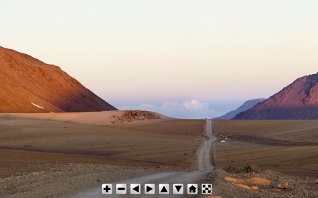ALMA
På jagt efter vores kosmiske oprindelse
Hvad er ALMA?
Højt på Chajnantor højsletten i de chilenske Andesbjerge driver European Southern Observatory (ESO) sammen med en række internationale partnere ALMA (Atacama Large Millimeter/submillimeter Array). Det er et højmoderne teleskop, som studerer lyset fra nogle af de koldeste objekter i Universet. Det er stråling med bølgelængder omkring en millimeter, imellem det infrarøde lys og radiobølgerne, og derfor kaldes det millimeter- eller submillimeterstråling. ALMA består af 66 præcisionsantenner spredt ud over et område på op til 16 kilometer. Dette verdensomspændende samarbejde er det største eksiterende jordbaserede astronomiprojekt.
Hvad er submillimeterastronomi?
Lys med disse bølgelængder kommer fra enorme kolde skyer i det interstellare rum. De har temperaturer, som kun ligger nogle tiendedele over det absolutte nulpunkt. Lys med disse bølgelængder kommer også fra nogle af de tidligste og fjerneste galakser i Universet. Astronomerne kan studere de kemiske og fysiske forhold i molekylskyerne - de tætte områder med gas og støv, hvor nye stjerner dannes. Oftest er disse områder i Universet mørke og uigennemtrængelige for synligt lys, men de skinner klart i spektrets millimeter- og submillimeterområder.
Hvorfor er ALMA anbragt højt i Andesbjergene?
Millimeter-og submillimeterstråling åbner et vindue ud i det gådefulde kolde Univers, men de svage signaler fra rummet bliver meget let absorberet af vanddamp i Jordens atmosfære. Derfor må teleskoper til dette formål bygges på højtliggende og tørre steder, som for eksempel Chajnantor højsletten 5000 meter over havet. Det er et af de højestbeliggende astronomiske observatorier i Verden.
ALMA ligger 50 km øst for San Pedro de Atacama i det nordlige Chile. Det er et af de tørreste steder på Jorden. Derfor er der uovertrufne muligheder for astronomiske observationer, men det er meget vanskelige forhold at arbejde under for astronomerne. Chajnantor er mere end 750 højere oppe end observatorierne på Mauna Kea, og 2400 meter højere end VLT på Cerro Paranal.
En rundtur på Chajnantor Plateauet
Klik på billedet for at få en Virtual Tour i og omkring Chajnantor.
Angående besøg ved ALMA: se Media Visits
Hvorfor er ALMA et interferometer?
ALMA er eet enkelt teleskop, men med et specielt design. Det består af 66 individuelle meget præcise antenner, og det observerer ved bølgelængder mellem 0,32 og 3,6 mm. Hovedkonfigurationen har 50 antenner, som hver er 12 meter i diameter, og de arbejder sammen som eet stort teleskop; et interferometer. Der er yderligere et anlæg bestående af fire 12 meter og tolv syvmeter antenner, som supplerer hovedanlægget. De 66 antenner kan anbringes i forskellige konfigurationer, hvor den maksimale afstand imellem antennerne kan variere fra 150 meter til 16 kilometer. Det gør det muligt at "zoome" med ALMA. Anlægget kan undersøge Universet i millimeter- og submillimeterbølgelængder med en hidtil ukendt følsomhed og opløsningsevne. Skarpheden er op til ti gange større end med Hubble rumteleskopet, og kan sammenlignes med de billeder, som tages med VLT interferometeret i andre bølgelængder.
Forskning med ALMA
 ALMA er det kraftigste teleskop, der findes til at observere det kolde Univers -
molekylær gas og støv. ALMA studerer stjernernes byggesten, planetsystemer,
galakser og selve livet. Anlægget giver forskerne detaljerede billeder af
stjerner og planeter under dannelse i gasskyer i nærheden af Solsystemet, og
kan finde fjerne galakser i udkanten af det synlige Univers. Det er galakser
som de så ud for omkring 10 milliarder år siden, og derfor kan observationer af
dem fortælle astronomerne om nogle af de dybeste spørgsmål vedrørende vores
kosmiske oprindelse.
ALMA er det kraftigste teleskop, der findes til at observere det kolde Univers -
molekylær gas og støv. ALMA studerer stjernernes byggesten, planetsystemer,
galakser og selve livet. Anlægget giver forskerne detaljerede billeder af
stjerner og planeter under dannelse i gasskyer i nærheden af Solsystemet, og
kan finde fjerne galakser i udkanten af det synlige Univers. Det er galakser
som de så ud for omkring 10 milliarder år siden, og derfor kan observationer af
dem fortælle astronomerne om nogle af de dybeste spørgsmål vedrørende vores
kosmiske oprindelse.
ALMA blev indviet i 2013, men allerede i 2011 begyndte observationerne da anlægget kun var delvist færdiggjort. Se pressemeddelese eso1137 for mere om dette.
ALMA er et partnerskab imellem ESO, U.S. National Science Foundation (NSF) og the National Institutes of Natural Sciences (NINS) of Japan i samarbejde med Chile. ALMA finansieres af ESO på vegne af medlemstaterne, af NSF i samarbejde med National Research Council of Canada (NRC) og the National Science Council of Taiwan (NSC) og af NINS i samarbejde med Academia Sinica (AS) på Taiwan og Korea Astronomy and Space Science Institute (KASI).
Konstruktion og drift af ALMA ledes af ESO på vegne af medlemstaterne, af National Radio Astronomy Observatory (NRAO), styret af Associated Universities, Inc. (AUI), på vegne af North America; og af National Astronomical Observatory of Japan (NAOJ) på vegne af East Asia. The Joint ALMA Observatory (JAO) bidrager med den fælles ledelse og styring af konstruktion, igangsættelse og drift af ALMA.
Videnskabelige mål
Stjernedannelse, molekylskyer, det tidlige Univers.
Mere om ALMA Observatoriet
- ALMA Antennerne
- ALMA Transportørerne
- ALMA og Interferometri
- ALMA Residencia
- Der flere interessante facts på FAQs page
- Læs mere om observatoriet i folderen ALMA Handout i PDF format
- Find flere billeder i ALMA Image Archive og i ALMA Video Archive fra ESOs multimediearkiv
- For forskere: Find flere oplysninger i vore technical pages
- Besøg på ALMA Observatoriets website
ALMA Planetarieforestillingen
"In search of our Cosmic Origins" er en inspirerende forestilling om ALMA, Verdens største astronomiprojekt. Forestillingen er gratis. Læs mere på Cosmic Origins website.
ALMA Trailer
Download denne trailer i andre formater i Video Archive.
ALMA
|
|
|
ALMA på Google Maps
Antenneikonerne viser — i real time — hvor de enkelte antenner befinder sig på Chajnantor plateauet (AOS)



